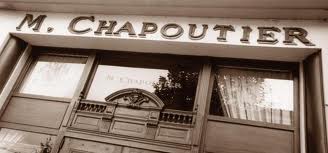Michel Chapoutier: « Just like Maison M. Chapoutier‘s arms, the 2013 vintage will be very “Fac et spera”. It took us a lot of patience with the nature and great boldness in our observations and choices. Photographs of a grape variety in a specific vintage on a given terroir, the single-vineyards wines will reveal great surprises this year. The first surprise comes from the white wines that almost show a Burgundian balance, which does not bother me at all!”
The first plots in the Northern Rhône Valley were picked over the week commencing 23rd September, in Saint-Péray. In Saint-Joseph, white grapes were picked and the first early white grapes from Hermitage were sorted over the same week. The mild temperatures and frequent south wind over the last ten days of September accelerated the end of the red grapes’ ripening process. The bulk of the harvesting took place in the first week of October, starting with the early ripening Cornas vineyards and Côte-Rôtie, followed by Crozes-Hermitage and Saint-Joseph. The excellent health of the red grapes of Hermitage meant that we could afford to leave them to conti-nue ripening until the week commencing 7th October.
Without doubt, the hard work in the vineyards, in terms of green harvesting and multiple applications of herbal infusions and plant decoctions, had been effective in controlling the various threats and in keeping the foliage fully effective until maturity. So effective in fact, that the balances shown at the harvest indicated potential degrees between 13 and 14% and pHs of about 3.2 for the whites and 3.4 for the reds. It is difficult to pass final judgment on red wines at this stage, but the first tastings show a character that already reflects the origins of the wines, in terms of both texture and aromatic expression.
The consequences of the late harvest which characterizes 2013, were felt outside the Northern Rhône Valley. The Châteauneuf vineyards suffered a wet winter (>400mm from November to March) and a late spring where warm temperatures struggled to make an appearance, resulting in a delayed bud burst, three weeks later than in 2012. Even more than in the North, the first stages of growth of the vine were affected by the spring temperatures warming up slowly ‘in steps’. The last ten days of April (barely reaching an average temperature of 12°C) had the combined effect of com-plicating the early stages of ovule differentiation in the flower buds and of signifi-cantly slowing down the growth rate. This
meant that during the flowering period reserves were drawn to the foliage at a time when the flowering usually requires all the energy generated by photosynthesis. Flowering itself took place in unusually cool daily minimal temperatures (averaging <8°C in the last ten days of May). The Grenache was heavily affected by fruit set failure (coulure). This grape variety is particularly sensitive to this phenomenon, even in less difficult climatic conditions. Coulure was particularly noticeable on the old vines, which had already been hit harder than the young vines by the heavy frosts in February 2012.
Fortunately, in one way, the spring hydrological regime, which had certainly not been depleted, (243mm of rainfall over April and May) encouraged the early formation of secondary shoots. The improved weather conditions in June (which continued all through the summer, reverting to normal local weather patterns) promoted, on these secondary shoots, an abundant and
homogenous flowering, benefitting fully from the photosynthesis of the primary shoots now almost relieved of their own growth. At this stage, the skill and experience of the wine grower were crucial. The wine grower had to retain only those second generation grape clusters at an advanced stage of development, because the lateness of the vintage and the threat of violent September thunder storms had dashed any hopes of heterogeneous grape clusters reaching full maturity.
After thundery weather throughout France in July, August stayed fairly dry (15mm) which caused a moderate deficit in water levels, benefitting a slower rate of growth and ripeness.
The grape harvest got underway on 23rd September, the Syrah was picked first, but the Grenache needed 15 days longer to reach anticipated physiological ripeness. As the post-fermentation macerations draw to an end, the wine shows generous fruitiness with some vigour, certainly very different from the classic generous Châteauneuf style but with an
uncomplicated expression and a fruity Pinot-type character, typical of the Grenache in a late vintage.
Read the 2013 Full Harvest Reports from Maison M.Chapoutier:
3) READ ALSACE
(Write to info@vitabella.fr)



